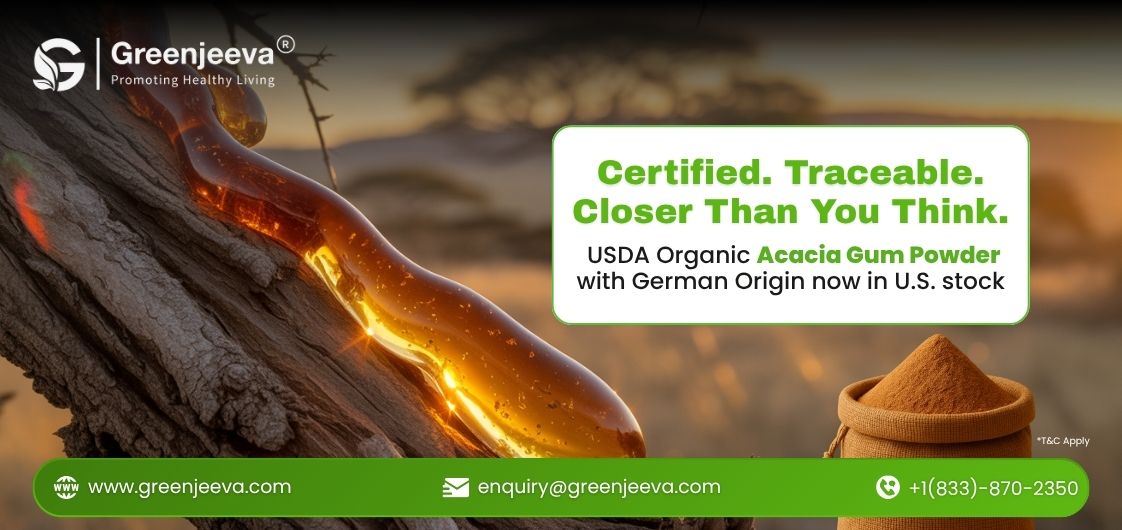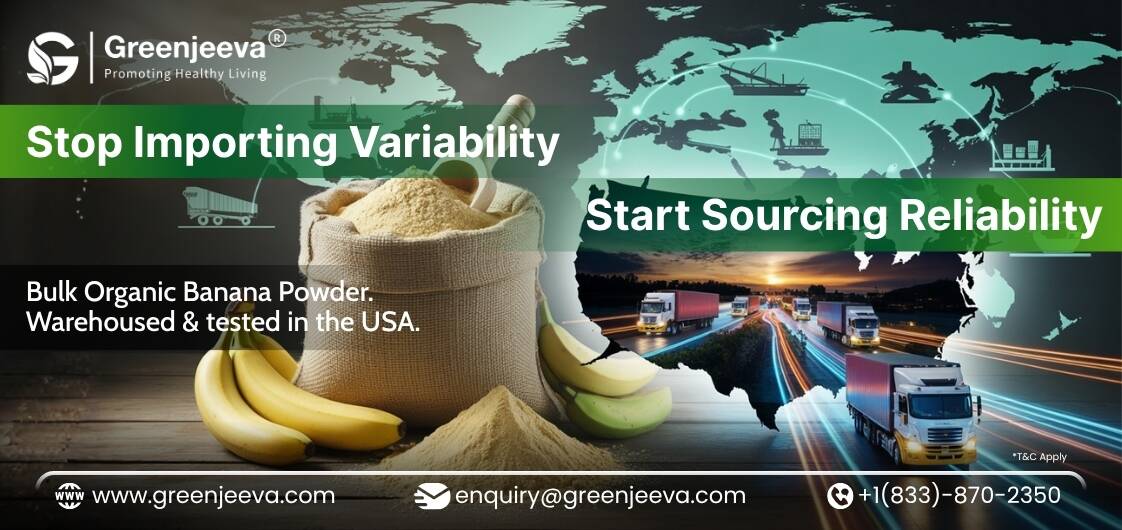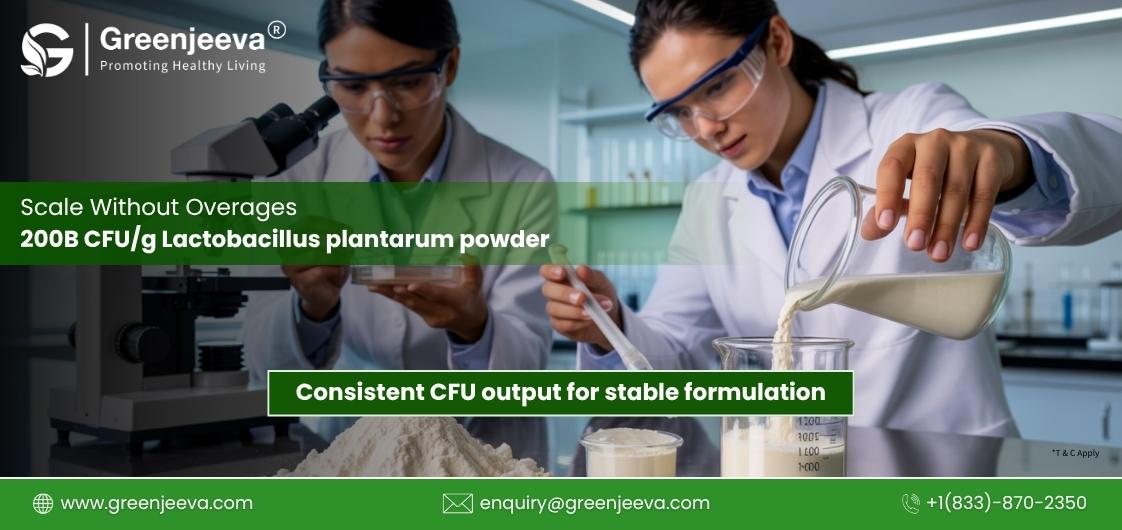Bulk Organic Acacia Gum Powder Supplier USA: Clean Label, Certified, and Closer Than You Think

What used to be a simple natural thickener is now a regulatory and branding differentiator. Organic Acacia Gum Powder—also known as Gum Arabic—has quietly become one of the most sought-after clean-label stabilizers across North America’s food and nutraceutical industries.
The global acacia gum market, estimated at USD 526 million in 2024, is projected to reach USD 762 million by 2030, expanding at a 6.4 % CAGR (Grand View Research, 2024). Demand growth stems from three converging trends:
- Consumer rejection of synthetic emulsifiers such as polysorbates 80 and modified starches.
- Risin inclusion of acacia gum as a soluble dietary fiber (recognized by the FDA).
- Growing regulatory and retailer pressure to validate “organic” and “natural” claims.
Yet the very surge in demand has intensified risk. A Food Integrity Global report (2024) found that nearly 18 % of commercial gum arabic samples were adulterated with starch or maltodextrin. The same period saw import delays and COA mismatches that led to multiple FDA port holds for hydrocolloid shipments.
That’s why buyers across the U.S. are turning toward US-based suppliers stocking German-origin, USDA-certified organic acacia gum—where quality, documentation, and fulfillment speed align with clean-label promises.
Technical Validation: What R&D and QA Teams Must Confirm
Every procurement decision begins with a lab report. For R&D and QA teams, the question is clear: does the powder perform and comply?
Solubility & Functional Behavior
Authentic bulk organic acacia gum powder (biological source: Acacia seyal) disperses instantly in cold water to form a stable colloidal solution.
- Viscosity (25 % in H₂O): 60 – 150 mPa·s
- pH (10 % solution): 4 – 5
- Appearance: Yellowish to brownish, uniform texture
Stable viscosity indicates correct molecular-weight distribution—key for emulsifying essential oils, stabilizing beverage concentrates, or binding nutraceutical tablets. Inconsistent viscosity often signals moisture exposure or adulteration.
Purity & Consistency
A compliant lot should show:
- Loss on drying ≤ 10 % (USP <731>)
- Total ash ≤ 10 % (USP <561>)
- Acid-insoluble ash ≤ 0.5 %
Uniformity across batches ensures predictable texture and performance—essential for continuous manufacturing lines.
Microbial & Heavy-Metal Integrity
FDA and CFIA both classify microbial contamination among the top five causes of ingredient detentions (FDA Import Data 2023). Reputable suppliers maintain:
- TPC ≤ 100 000 cfu/g, Yeast & Mold ≤ 1 000 cfu/g
- E. coli / Salmonella — Absent
- Total heavy metals ≤ 10 ppm (Lead ≤ 2 ppm, Arsenic ≤ 3 ppm)
Third-party validation using USP <2021>, <2022>, and <232> guarantees compliance for U.S. and Canadian audits.
Shelf-Life Stability
Moisture absorption alters viscosity and microbial load. Domestically warehoused lots—stored under ≤ 60 % RH—retain consistent rheology for up to 36 months, according to stability data from the European Hydrocolloid Research Institute (2023).
Procurement & Documentation Readiness: Where Supply Meets Compliance
Documentation Integrity
Every COA must correspond exactly to the shipped batch. Procurement teams should verify that each lot number links to:
- USDA Organic Certificate (NOP compliant)
- Third-party lab COA (including heavy metals & microbial tests)
- MSDS / Allergen Statement
- Specification Sheet + TLC or FTIR identification
A mismatch between the certificate and physical batch is the fastest route to customs delays. According to FDA FSMA import data, documentation discrepancies account for ~14 % of entry rejections (2023).
Local Warehousing = Procurement Resilience
A shipment delayed at port costs time and shelf life. Having a domestic warehouse in the USA solves multiple pain points:
- Lead time cut from 6 weeks to 3 days for most orders.
- Reduced customs exposure: goods already cleared through U.S. channels.
- Improved COA verification: QA teams access docs before the batch ships.
Temperature-controlled storage in local facilities also preserves the powder’s low moisture level and prevents caking—critical for ensuring solubility on rehydration.
Audit Readiness
Procurement success now means being “audit-ready.” Suppliers with ISO 22000 + GMP systems provide document packages aligned to both FDA FSVP and CFIA Safe Food for Canadians requirements. Having those files at hand reduces brand risk during retailer audits and private-label approvals.
Adulteration Awareness: Protecting Brand Trust
Adulteration is not an abstract threat—it’s quantifiable loss. A 2024 study in Food Chemistry Advances revealed that nearly one in five gum arabic samples from open markets contained starch or dextrin fillers.
For a bulk buyer, that means:
- Inconsistent viscosity → failed batches → production waste.
- “Organic” labels under scrutiny → regulatory penalties.
- Undeclared fillers → consumer trust erosion.
Verification Protocol
Before signing a purchase order, buyers should:
- Request TLC / FTIR fingerprint proving gum identity.
- Cross-verify COA against independent third-party testing.
- Audit supplier certifications (USDA, ISO 22000).
- Review supply-chain traceability —from exudate collection to final packaging.
Every checkpoint prevents the “cheap bulk” trap that turns into million-dollar recalls.
Market Momentum & Application Trends
Clean-Label Acceleration
Mintel (2025) projects that by 2027, 72 % of new beverage launches in North America will carry a clean-label or plant-based claim. Acacia gum’s dual role as emulsifier + soluble fiber makes it indispensable for this transition.
Functional Foods & Fiber Fortification
With the FDA recognizing acacia gum as dietary fiber (2018 Guidance), formulators can legally list it as fiber on Nutrition Facts panels—boosting value for wellness beverages, prebiotic formulations, and meal-replacement powders.
Cosmetic & Personal Care Crossover
The global natural-cosmetics market hit USD 45 billion in 2024 (Statista). Cosmetic chemists use organic acacia gum as a natural thickener that improves spreadability without synthetic polymers—creating cross-industry pull on supply.
Local Sourcing Advantage: Why “Closer” Matters
- Predictable Supply Chain: German-origin material stocked in the USA eliminates dependency on conflict-prone African sourcing corridors.
- Fresher Inventory: Shorter transit reduces oxidation and moisture uptake, protecting functional performance.
- Lower Carbon Footprint: Regional distribution cuts trans-Atlantic shipping emissions by ~25 % (World Logistics Council Data 2024).
- Faster Quality Approvals: QA teams receive COA + specs within 24 hours instead of waiting weeks.
Supplier Checklist: The Smart Buyer’s Playbook
When evaluating a bulk organic acacia gum powder supplier in the USA, procurement and QA teams should confirm: This single-page checklist aligns every department—QA, Procurement, Regulatory—on measurable parameters before finalizing any vendor.
Clean Label & Compliance Pay-Off
For brand owners, every clean-label choice is a compliance investment. Organic Acacia Gum Powder allows “organic,” “plant-based,” and “fiber source” claims while staying free of allergens, GMOs, and synthetics.
Alignment with USDA (7 CFR 205), NOP Organic, and CFIA Organic Equivalency ensures dual-market acceptance for U.S.–Canada trade—crucial for contract manufacturers serving both regions.
Key Takeaway: From Risk to Readiness
In 2025, the differentiator in B2B ingredient sourcing isn’t price—it’s proof. Procurement managers who once compared quotes now compare COA integrity, traceability, and warehouse proximity.
Choosing a U.S.-basedbulk organic acacia gum powder supplier with German origin, USDA certification, and local inventory means:
- Zero-delay dispatch for JIT production.
- Third-party-verified COAs and microbial safety.
- Audit-ready document packages.
- Lower risk of adulteration or substitution.
- Reduced carbon footprint and import complexity.
- Clean-label may be a marketing term for consumers, but for procurement teams—it’s a compliance strategy that protects brands and supply chains alike.
Ready to streamline your supply chain?
Download batch-linked documentation or a free sample of our bulk organic acacia gum powder and experience certified quality — delivered locally, verified globally.



.jpg)

